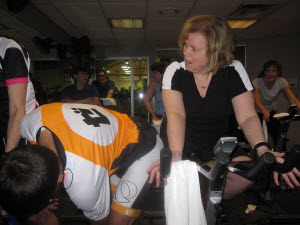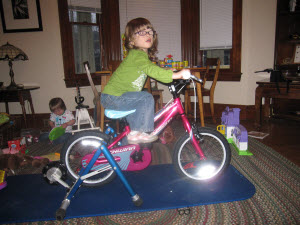
“In the field” bike fits can lead to uncomfortable situations like this!
Coming Home
Recently, during a visit to my parents, I had the urge to visit my old High School. Upon arriving, Track was in session, so I took a walk down glory lane as memories of my High and Long Jumping career came rushing back. Surprisingly, all 3 of my track coaches were still there, 20 years post graduation. Before long, I was mentoring up and coming high jumpers from 7th to 12th grade.
Coach Caroll, my head coach, was off at the discus cage working with a special student athlete. Tim recently had a bout with cancer, and though now cancer free, was blind as a result of the cancer medication. It was quite something special to see Coach Caroll verbally instruct to this athlete the technique of throwing the discus. Tim was well humored considering his misfortune, but was also clearly frustrated. After a failed throw he said “I just want to throw like a did before.” Coach didn”™t miss a beat and said, “with out form, you got nothing...no speed, no distance, no power.”
Discussing form in cycling, we are usually referring to how we pedal, with force and cadence. But form can also refer to how we are positioned on the bike. In the discus event we can have great power, force and speed with the throw, but if our footprint is off, it won”™t matter. In cycling our starting position or “footprint,” determines how we interact with the bike and in-turn (pun intended), improve our ability to have success.
How Class Begins
It is Monday night 5:29, 1 minute before go time. Your pre-class music is playing, there is excitement in the air with student banter, and the room is almost filled to capacity. The regulars are way set up, and have been turning the pedals for 10 minutes, eager to start the best part of their day. You strap on your mic, mount your stead, and one more person sheepishly walks in. They find an open bike and look at it like a foreign object. Then, they find the courage to look up and ask, “can you set me up?
That first 5 minutes is so important as it lays down the groundwork. Yet, this person is a fragile egg. It took everything they had to enter the room for the first time. You have an obligation to keep everyone safe with proper bike fit, and create a positive open environment, not a clique of local fitness heros. If they don”™t have a good first experience, they will never come back. Remember regulars were first timers once too.
Though there is no audible sound, you sense the rooms displeasure as you step down. The Hammers are giving you and newbie the evil eye. You pinch yourself between bikes and rush nervously through the fit. Getting knee over pedal is almost impossible without shoving your spandex into some else”™s personal space.
As you finish, the dominos start to fall. “Can you set me up too? Yeah me too!” 5 minutes late now and into your second song(which you spent 20 minutes picking out as the perfect progression from intro/warmup), you frantically try to get back on track. Your bike fits were sub par, attitudes are everywhere, and the mojo is gone. We have all been here, pulled in every direction. What can you do to end this tug of war between punctuality, safety, and success?
Empower Your Students!
What we need is a way to empower our students to fit themselves. We need to be just like Coach Caroll and verbally give a set of descriptive, yet simple instructions, so that any one can achieve a solid bike fit without an instructor manually turning knobs, raising and lowering saddles. At Stagesâ„¢ indoor cycling we have this simple, clever, package of verbal instructions called FastFitâ„¢.
Here is one example of our instructions that you can adapt for your own use. “Raise your saddle to the top of your iliac crest. Run your finger across from your navel to your side. Then go straight down until you reach the crest of your hip bone. Bring your saddle to this land mark.”
Will it provide the ideal fit? I can see all of you bike fit gurus scoffing and shaking your heads. I know what you are thinking. Bike fit is sacred ground, there is 3D imaging, plumb bobs, goniometers, and scientists performing this critical component. However, they are not doing this at 5:32PM, in a packed house, with minimal space. Our goal is to get people in a safe range while “in the field.”

Hannah, more than likely needs a more precise “hands on” approach for ideal bike fit.
If you walk into any cycle room it is almost guaranteed that someone will be riding with a saddle too low. However I can also almost guarantee that no one is riding with the saddle too high. Why? First, the rider will feel their foot disconnecting from the pedal at the bottom of the downstroke which is unsettling. Second, without getting too explicit, lets just say the pressure and movement on the saddle in THAT region will rub you the wrong way. Third, the rider will give a look of, “I don”™t think so” based on the first two sensations. The iliac crest method, if it is to fail, will set the saddle too high. This is quickly and eagerly remedied by the student and a quick cue of:
“The saddle should be as high as comfortably possible while still allowing a flat foot at the bottom of the pedal stroke, a slight bend in the knee, and minimal hip rocking.”
Will this work for everyone? Our system achieves success with 90% of the population, and I will fully admit the seat height landmark did not work for myself (my iliac crest is mad high). But, I have seen our FastFitâ„¢ 5 step system, designed by Stagesâ„¢ Indoor Cycling and specifically for Freemotionâ„¢ S-series bikes, achieve a safe set up 9 out of 10 times through many trainings.
I encourage instructors to develop their communication skills and design a set of instructions that works for their particular bikes. Can it replace a hands on approach with fitting tools and working space for observation? Of course not. It will however, quickly create an indoor cycle experience, where comfort is king, the fit will allow for safe and effective mechanics, and the room mojo will remain high.
- “Without Form, You Got Nothing” - April 21, 2012

Been there done that… great advice Doug…
I had to develop my own version of fast fit for survival. All of my certifications had me using plum bobs and goniometers. I was not prepared for the ‘real world’.
Thanks for that dose of reality.
Doug,
What cute little munchkins you have in the picture!!!
I didn’t realize that Hannah’s bike could fit into the
trainer, too!
Yes I think we’ve ‘all been there, done that’…with bike set-up and people arriving late. Grrrr. Somehow we seem to
always get past this with flying colors…it’s all part of being in the fit-show-biz! LOL
Thanks for sharing this all-too familiar scenario AND
those adorable bunchkins with us 🙂
Awesome Doug! Way ta’ represent 🙂